Search Engine Optimization: or Search Engine Optimization, is the cheapest and most effective way to increase website traffic. But what exactly is SEO and how does it work? How can you make SEO work for you? That’s what you’ll discover in this guide.
Table of contents
- What does SEO stand for?
- What is SEO?
- How does SEO work?
- Types of SEO
- On-page optimization
- Off-page optimization
- Technical SEO
- SEO ranking factors
- Benefits of SEO
- SEO tools
- SEO strategies and best practices
- Further learning
Today, when most of us need something – answers, ideas, products, strategies, or services – we turn to search engines first. Google alone receives 3.5 billion search queries every day. Just as search engines have become an integral part of our lives, they have also become an integral part of many companies’ marketing strategies. Moreover, for 49% of marketers, organic search is the channel with the highest return on investment.
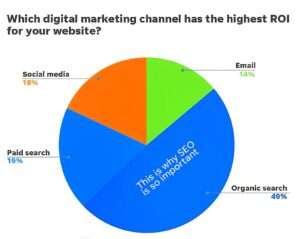
Organic search is a fancy name for natural search engine results without ads, and search engine optimization or SEO is how marketers use organic search as a marketing channel.
This comprehensive SEO guide will show you everything you need to know to rank well in Google, increase website traffic, and improve your brand reputation.
What does SEO stand for?
SEO is a term that means optimizing your website. Let’s break this down into the context of your web pages.
- Challenge: Definition: Someone with a website that provides information about a product or service that may be useful to consumers.
- Performer: An actor who has received information about a product online: Performer: Stránka (for example Google nebo Bing), where the person providing the information is located.
- Audience Optimization: What you do to engage viewers with your website from the above point of view.

What is SEO?
Just because RPA stands for robotic process automation doesn’t mean you know what it is.
The official definition of SEO:
Search engine optimization is a set of technical and content practices that align website pages with a search engine’s ranking algorithm so that they are easily discovered, crawled, indexed, and displayed in SERPs for relevant search queries. Being found, crawled, indexed, and displayed in SERPs.
A simple definition of SEO
SEO is improving the structure and content of your website so that search engines can find those pages.
The simplest definition of SEO:
SEO is what you do to rank high on Google and drive traffic to your website.
Google is just one of many search engines; there’s also Bing. There are also search engine directories. Instagram is also a search engine. But because Google has 92% of the market share, we’ll use the words “Google” and “search engine” synonymously in this article.

How does SEO work?
Therefore, How does Google decide which pages appear on the search engine results page (SERP) for a particular search query and how does this affect website traffic? Let’s take a look at how search engine optimization works.
- The Google search engine is constantly crawling the internet, collecting, categorizing and indexing billions of web pages. When a user performs a search and gets results, Google pulls them from its own catalog, not from the Internet itself.
- Google uses complex formulas (known as algorithms) to rank the results based on a number of criteria (known as ranking factors – more on these later), including the quality of the content, its relevance to the search query and the website (domain name) it belongs to.
- The way in which users interact with the results tells Google what requirements the individual pages fulfill (or do not fulfill), and this is also taken into account in the algorithm.
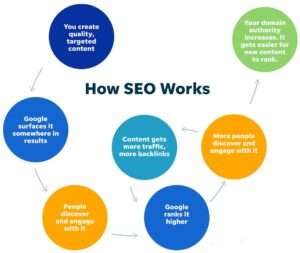
Types of SEO
SEO has many facets as Google and other search engines consider many factors when ranking content. There are three main types of SEO: on-page SEO, off-page SEO, and technical SEO:
- On-page SEO: Optimizing the quality and structure of content on a page. Quality content, keywords, and HTML tags are the key elements of on-page SEO.
- Off-page SEO: providing links from other sites and other pages on the site to the page you want to optimize. Backlinks, internal links, and reputation are key elements of off-page SEO.
- Technical SEO: optimizing the overall performance of the site in search engines, where site security (SSL certificates), user experience, and structure are key elements.
The above three types of SEO are used for websites and blogs but also apply to the following three sub-types
- Local SEO: Optimizing your Google reviews, listings, and business profile is essential to ensure your business appears as high as possible in local search results on Google and Google Maps.
- Image search engine optimization: Combining technical and internal strategies to ensure that the images on your website pages rank highly in Google image searches.
- Video SEO: combines on-page, technical, and off-page strategies to ensure that videos rank highly in YouTube and Google Video search results.
All three sub-types require the three basic types of SEO but rely on each of the basic types to varying degrees.
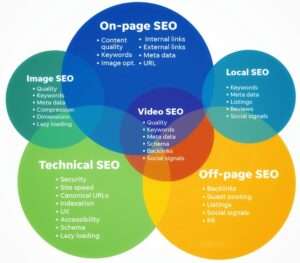
How to On Page SEO Optimization?
Now it’s time to talk about SEO, that is, optimizing your website according to these factors so that it ranks higher on Google and gets more traffic. This involves a combination of on page seo, off-page and technical optimization. Here are the steps of on-page optimization
- Start with keyword research.
- Create quality content targeting keywords
- Embed keywords
- Optimize headlines
- Optimize meta descriptions
- Add and optimize images
- Internal and external links
Start with finding keywords for search engine optimization
Secondly, The first step in search engine optimization is to identify the keywords you want to optimize for. These are the terms that visitors to your website are likely to type into Google and other search engines. Each page of your site should target different keywords to avoid them competing with each other.
How to do keyword research for SEO?
Here are the basic steps to find the best keywords to use for your organic content:
- Make a basic list: Start by making a list of words and phrases that your ideal customer would type into Google. Think about their interests, wants, challenges and goals, recognizing that their language may be different from yours (as an expert).
- Add these to a keyword research tool: keyword research tools can provide you with data on these keywords. Criteria include.
- Search volume: how many times the keyword was searched for in a month.
- Competition: how difficult it is to rank for this keyword.
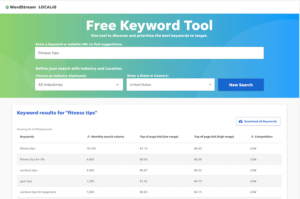
SORTING AND PRIORITIZING: Put the resulting terms and data into a spreadsheet. This will allow you to group and prioritize them into key headings. Ideally, you want to target keywords with enough search volume to get enough reach, but not so much that the keyword is too competitive to rank high. It is better to appear on the first page for a keyword with low search volume and low competition than to not rank at all for a keyword with high search volume and high competition.
For detailed guidelines on how to research keywords, please click here.
Create quality content targeting these keywords
While the main navigation pages (home, About Us, Contact Us, Products, and Services) will be targeted for keywords, most keyword targeting will come from long-form content in the form of blog posts. High-quality SEO content
- Think about your target keywords: make sure your content provides the information people are looking for when they search for that keyword. This is why you should always Google the keyword first.
- Provide a good experience: do not include pop-ups, calls to action, or other distractions, and use images to illustrate the concept and ensure that it loads quickly and correctly on all devices (more on this in the Technical SEO section).
- Read naturally: do not use keywords. Write in a way that speaks to your target audience, not content writers trying to optimize for search engines.
- Be comprehensive: Google is not interested in weak, duplicate, or low-quality pages. This means 1,500 to 2,500 words of accurate and up-to-date information.
- Be organized: Use heading tags to indicate the hierarchy of information on the page.
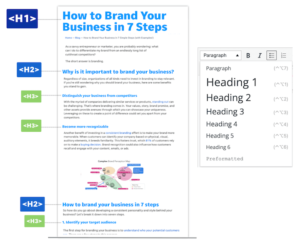
Keyword placement
In addition to the natural placement of keywords in the main content, keywords must be placed in specific locations within the page to indicate to Google which keywords you want to rank highly for. This includes
- SEO title (title tag)
- Page title (H1 tag)
- At least two H2 labels
- Image alt text
- Image file name
- Naturally, in the main text
- URL
- Meta description

Heading optimization
Each page on a website already has two titles. The title is the heading that appears in the SERPs and is the most effective place to put keywords; the H1 tag is the title that appears when you click on a page. Whether or not these titles are the same depends on the page.
To optimize your titles, you should
- Include your keywords: If they are natural and attractive, add appropriate modifiers around them.
- Use only one H1 per page: this should be the title, and H2 should be used to indicate the main section.
- Keep the title tag to 55-60 characters: the amount Google will display varies (depending on the number of pixels, not characters), so keep your keywords up front.
- Show value: This will affect whether it gets clicked on in the SERPs or continues to be read on your site.

Optimize Meta Descriptions
The meta description is the description that appears below the title tag in the SERPs. google prefers to create its own description based on the query, but it is still important to optimize it for SEO. google reads this description when it crawls the page and understands what the page is about.
To optimize your meta description
- Include relevant keywords and keyword phrases in a natural and attractive way, if possible.
- Keep it short: The ideal length for a meta description is 155-165 characters.
- Make it attractive: Remember, appearing in search results is only the first step! You need to get searchers to click on your site. Include a short description, clear benefits, and a call to action similar to your ad text!
Below is an example of an actual meta description that will appear in search results
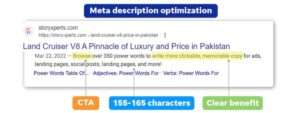
Adding and optimizing images
Images are an important component of search engine optimization. Images allow users to interact with your page, improve the quality of information, rank your page through image results, and give you the ability to generate traffic to your home page. Additionally, Google is increasingly working to make its SERPs more visual.
Here are some ways to improve the SEO of your images:
- File name: Save file names that contain keywords with hyphens instead of spaces.
- Add alt text: alt text refers to the alt text of an image that indicates how Google “sees” the image on the page and understands its relevance to the keyword. It also makes the image more accessible to screen readers and the alt text will still be visible even if the image is disabled. Do not insert keywords haphazardly. Imagine describing an image to someone who cannot see it!
- Compress images: Large images slow down the display speed of your site. Compress them to reduce the file size and make sure they are the right size. Depending on the site, no image should be larger than 1000 pixels.
internal and external links
Internal and external links should be included when performing SEO for blog posts.
- External links: find 1-3 pages on other sites with high domain authority that are relevant to your topic and link them to your article. This helps build trust in Google.
- Internal linking: link to other articles on your site within the content of the article you wrote. Similar to the last point, use “high domain authority” for your anchor text. This way, Google will have multiple pathways to individual articles, making it easier to crawl the entire site. The number of links you publish will depend on the length of the post and the amount of other content you can link to. Links should be relevant to the page and anchor text.
Off-page SEO tactics
Firstly, All of the above steps are on-page SEO strategies. On the other hand, off page SEO is what you do on other pages of your website, on other websites, and even on other platforms to help your pages rank. Here are the following off-page SEO tactics
Get backlinks.
Backlinks, or links from other websites to your website, are the third most important ranking factor on Google. Of course, backlinks from authoritative sites are more valuable than those from less authoritative sites. The more quality backlinks you have, the higher your ranking will be.

So how can you increase your backlink count? There are many strategies, some of which are mentioned below:
- Create original and authentic content that is worth getting backlinks for.
- Actively link to sites that can benefit from linking to your content.
- Guest Posting
- PR coverage.
Share your content on social media
In addition to putting links to your website on your social media profiles, regularly share blog posts on your channels. This will generate referral traffic and the more traffic the post attracts, the more likely it is to generate backlinks. While social media itself is not a direct factor in Google rankings, your activity on the platform and users’ interaction with your content there will send social signals to Google that will influence your rankings.
Boost your brand reputation
Google doesn’t just look at a single page when determining the ranking of a particular page on your website. It looks at your brand as a whole by looking at other information on the web, such as reviews, ratings, listings, awards, and even links to unrelated brands. That’s why Search Engine Optimization needs to work on boosting your brand’s reputation by optimizing listings, getting positive press coverage, and earning reviews. While most of this falls under the realm of local SEO, many brand-building strategies apply to businesses other than local stores.
Search Engine Optimization Methods Technical SEO
Technical SEO is done on the backend of your website to make sure you meet Google’s site security and user experience requirements and to make it as easy as possible for Google to work with your site. This section describes technical seo :
Page Speed: In addition to image size, the code and loading order of your website’s content can also affect page speed. Therefore, it is important to slow down the loading time and optimize for page speed.
Security: Ideally, users should be able to access any page on your site in three clicks or less. Internal links are very important here.
Mobile-first: It no longer matters if your site is mobile-friendly – now that Google’s index is mobile-first, your site must be fully responsive.
Key Web Viability Metrics: These three metrics are used to measure the user experience of a page. Learn more about how to optimize your core web biometrics.
Website Architecture: A structured website architecture, including blogs, landing pages, and product groups, facilitates Google crawling, user navigation, and data segmentation in reports. Canonical URLs: Canonical URLs are URLs that represent a group of duplicate pages; Google will do its best to identify canonical URLs for duplicate pages, but you can also show Google using canonical tags or 301 redirects. For example.
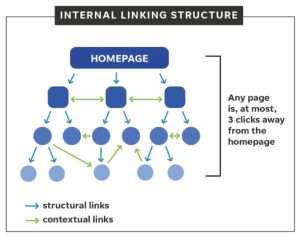
- http://storyxperts.com
- http:// storyxperts.com/
- https://www. storyxperts.com
- https://www. storyxperts.com/
- https://www. storyxperts.com/
- All redirects are made to this base URL:
- https://www. storyxperts.com
Crawling/Indexability: Sitemap and robots.txt can be used together to tell Google what you want it to crawl or index and what you don’t want it to do.
Schema markup: Schema markup allows Google (and other search engines) to understand the type of content you have and display rich results where possible. For example, schema links to your site can provide more SERP placement:
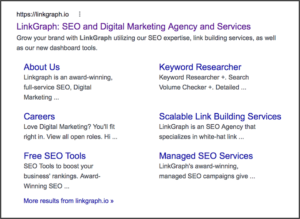
There are many types of schemas that apply to different types of businesses. For more information on schemas and tagging, see our guide to SEO schemas.

SEO rankings factor elements for Google
What makes quality content optimized for search engines? There are hundreds of ranking factors in Google, and while Google is always refining and improving its algorithm to provide the best possible experience, there are 12 factors you should prioritize.
At FirstPageSage, we believe these are the most important Google seo ranking factors and how they are evaluated:
- Consistently publishing quality content (26)
- Meta title keywords (17)
- Back Links (15)
- Specialization (13)
- User engagement (11)
- Internal connections (5)
- Mobile-friendly/mobile-first (5%)
- Page speed (2%)
- Site security/SSL certificate (2%)
- Tag schema/structured data (1%)
- Keywords in URL (1%)
- Keywords in H1 (1%)
However, the last factor in the list should not be confused. As you can see in the table below, “other” factors such as broken link signals, social signals, domain history, outbound links and site structure are weighted at 1%. However, given that Google has at least 200 ranking factors, there are at least 189 “other” factors that add up to 1%, which means that small factors that only account for 1%, such as keywords in your URL, are actually not that small.

Benefits and Importance of Search Engine Optimization
People search for information about your business in a variety of ways, directly or indirectly. These searches are an opportunity to engage with people, answer their questions, solve their problems, and become a trusted resource.
- Increased Website Traffic: A Benefits search engine optimization website not only increases brand awareness but also drives more traffic.
- More customers: When a website is optimized for keywords (words that ideal customers and visitors search for), it receives more relevant traffic.
- Improved Reputation: Ranking high on Google instantly increases trust in your business; when Google trusts you, people trust you.
- Improved Return on Investment: Invest money in your website and marketing campaigns to drive people to your website pages. A high-performing website improves the results of these campaigns and increases the value of your investment.

If you are looking for brand awareness, online visibility, leads, sales, and loyal customers, SEO can help.
Tools for Search Engine Optimization
Therefore, Effective search engine optimization is impossible without data, and tools are needed to obtain this data. Fortunately, most of them are free. The best SEO tools for optimal SEO strategies include
- Google Analytics: this is the gold standard for analyzing website traffic and it is free. It can be used for any SEO metric to measure performance, including traffic, time on page, page engagement, and pages per session.
- Google Search Console: GSC is essential for content-driven technical SEO. While some Search Console data is displayed in Google Analytics, the platform itself offers more functionality. Use it for basic website performance metrics, detailed query analysis, indexing, and more.
- Keyword Research Tools: As mentioned above, these tools are necessary to find realistic keywords to target in terms of search volume and competition. Check out our overview of paid and free keyword research tools to find the right one for you.
- SEO Software: If you are looking for more in-depth SEO metrics such as backlinks, competitive information, and advanced keyword data, you need paid SEO tools such as Ahrefs, Moz Pro, Screaming Frog, and SEMrush. Some of these tools offer free trials or free services for the first 500 links (or similar).
- Website Classification Tools: While the above tools are complex and often require knowing how to make sense of the data, website classification tools make SEO easier and provide more recommendations.
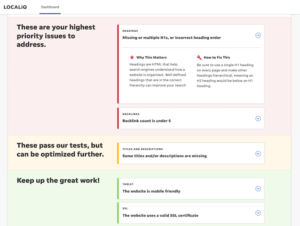
SEO strategies and best practices
Let’s wrap up with a few SEO strategies, best practices, and tips.
Always research your keywords: What users think they’re looking for when they do a specific search on Google might not actually be what they want. Keyword intent is important, so always research the keywords you want to target and make sure they are consistent.
Be patient: Seo takes time. A lot of time. It can take months before you see results, but once you start to see them, they add up over time!
Stick to quality: Google is constantly updating its algorithm and adding new features to the SERPs, but at the end of the day, it’s all about displaying the best content. So you should always focus on consistently producing useful and authoritative content – it’s the best SEO strategy of all.
Maintain your content: While consistently publishing quality content is an important part of achieving high rankings on Google, you can’t afford to let your content become stale. Update your evergreen pages regularly to maintain their SEO Strategies value and ensure that your traffic grows steadily over the long term.
Track and measure: Regularly report traffic and site data to see what topics resonate most with your audience, identify problems, and set goals for increasing traffic.
Continue learning about search engine optimization
This guide will help you get started with SEO, but there are many additional resources available to help you learn more about SEO. Finally, Most of these resources are linked in this guide, but here are a few additional resources to consider
- SEO basics: A beginner’s guide to SEO
- SEO basics: 10-step SEO audit and checklist
- Free course The Complete Guide to Local SEO
- Free download 25 ways to increase website traffic
- Free download 10 ways to get on the first page of Google
Finally, As mentioned above, you can get a free and instant SEO audit with our free website assessment tool.

